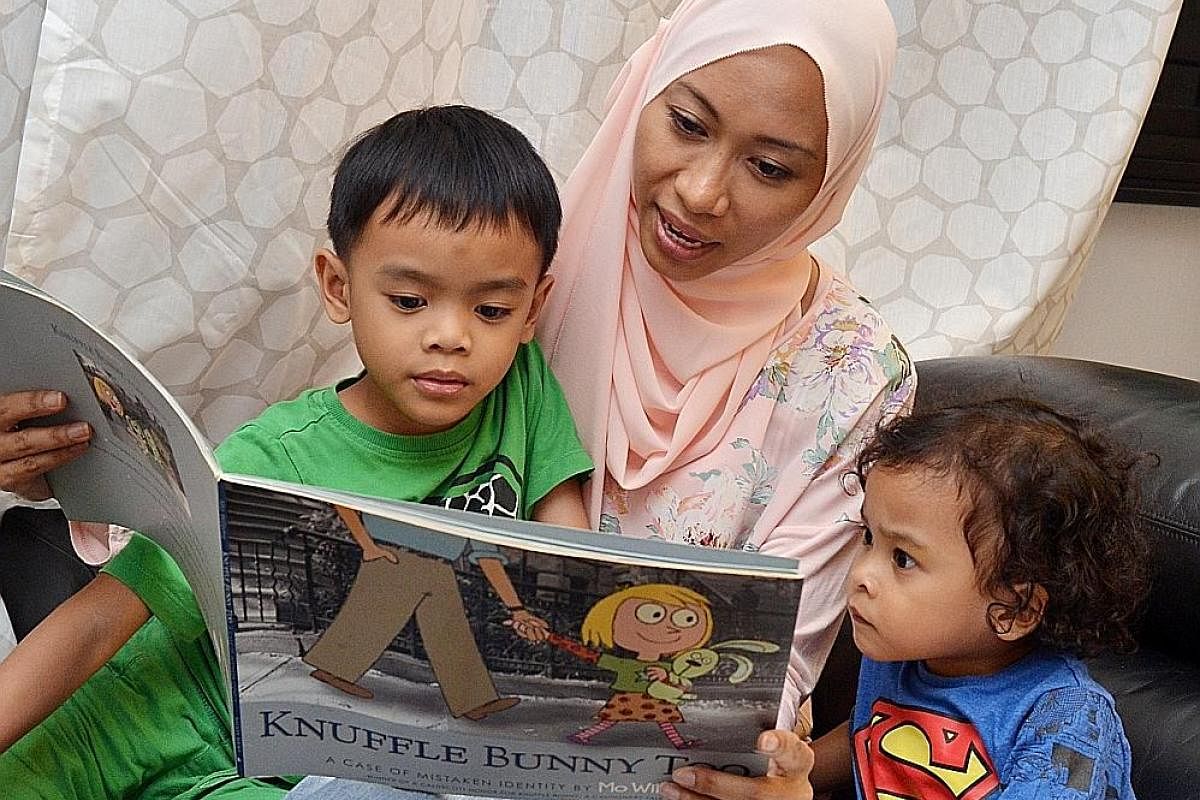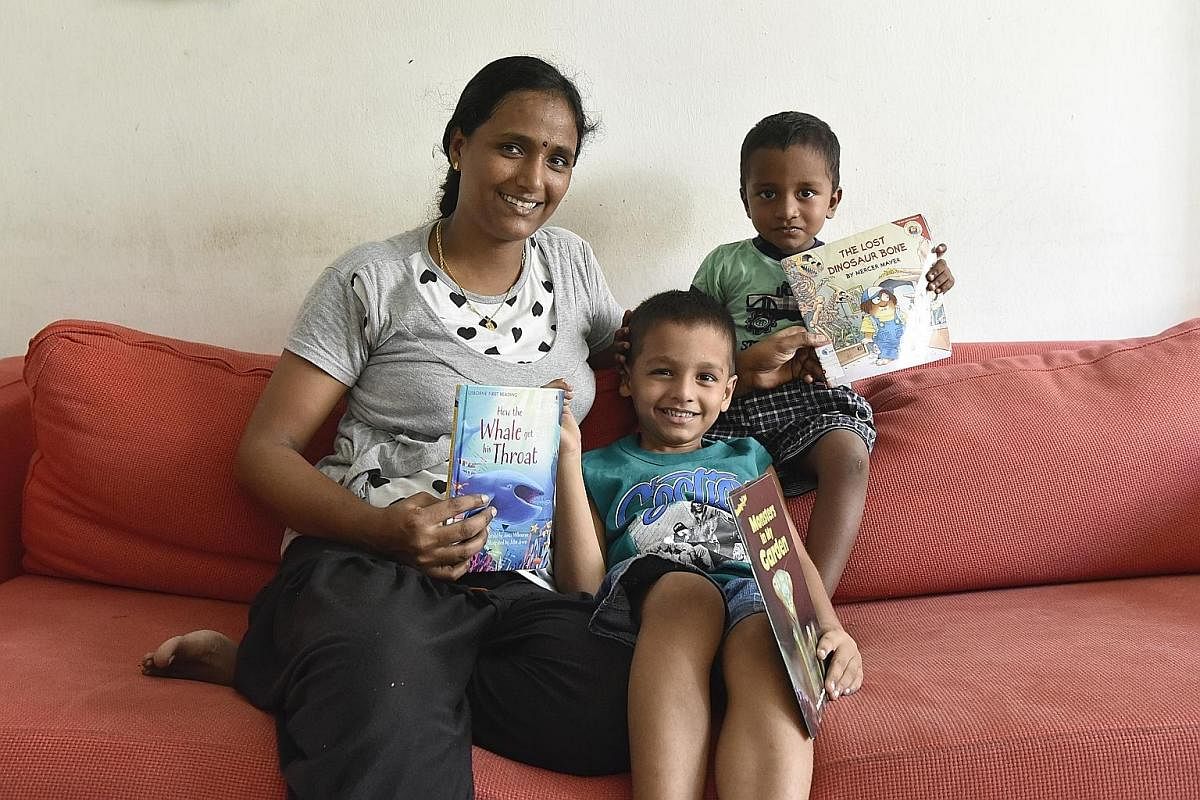-
Reading tips
-
• Encourage a love of books by reading to children, even when they are just babies and toddlers. Designate a time for reading so the child knows it is a time to focus and be quiet.
• Even before learning to read, young children can engage in sensorial, experiential learning such as through rhymes, songs and finger puppets.
• Help a child understand and contextualise what is being read. With a book about the seaside, for instance, talk about the child going to the beach.
• Choose books with content that the child is interested in.
• Use pictures as cues, such as by pointing at a picture of the sun to relate the word to the picture.•
• Learning to read can be incorporated into one's daily activities, and need not be restricted to books. The parent can write the word milk on a shopping list, for example, and the young child can begin to recognise the letter M.
• Shared reading is helpful in motivating children to read. This means, for example, that the parent can read a page, followed by the child reading a couple of words, or the parent can simply point to the one word that the child knows.
-
• Information provided by Ms Mala Sundram, head of department for Speech and Drama, and Readers and Writers, at Julia Gabriel Centre, whose services include reading and writing programmes for children aged 18 months to 12 years old.
How to teach your kids to read
Repetition and memorisation are key to teaching children to read, along with songs, poetry and role-playing, say experts


Young children often like to listen to the same stories over and over again. This could exasperate some parents, but not Ms Shamsiah Samsudin, 37.
She reads her children's favourite books to them repeatedly as part of her strategy to teach them how to read.
For one year, she had read Knuffle Bunny: A Cautionary Tale by author Mo Willems, about a toddler and her stuffed rabbit, to her elder son, Adyan Darius Juffrey, now six.
After that year, Adyan, at age three, could recognise and read some words that could be found in its sequel, Knuffle Bunny Too: A Case Of Mistaken Identity, whose plot involves jealousy over plush toys. By age four, he was "quite proficient" at recognising words, says Ms Shamsiah, a part-time instructor at an enrichment centre.
Accounts such as hers are not likely to reassure anxious parents whose children are about to enter primary school and are still unable to read. Teaching a child to read can be such a mysterious, baffling process that it can be easier for parents to send their kids to phonics classes instead.
For parents who wish to persist on their own, experts say that repetition and memorisation are key when it comes to young children learning to read.
"While it can be exasperating for most parents to read the same much-loved book over and over again, it is this repetitive quality that enables a child to recognise story patterns and predict outcomes with the comforting knowledge that the story will always begin and end in the same way," says Assistant Professor Rhoda Myra Garces-Bacsal from the Early Childhood and Special Needs Education Academic Group at the National Institute of Education (NIE).
It is also important to read aloud to children even before teaching them to read.
Dr Garces-Bacsal says: "I cannot over-emphasise the importance of reading aloud to your children regardless of how old they are. If a child is old enough to be spoken to, then he is old enough to be read aloud to."
When reading to her sons, Ms Shamsiah rotated Knuffle Bunny every couple of months with other reading materials such as picture books about cars. Such favourite tales were read aloud up to three times each night as part of the bedtime routine for Adyan and his brother, Adam Mika Juffrey, three. She started reading aloud to her children at night when they were about six months old and takes them to the library regularly.
Besides the use of repetition, she was also at ease with Adyan memorising, rather than reading, his favourite stories.
"I observed that my kids learn through memory and I read the story over and over again so they would enjoy it," says Ms Shamsiah, who is married to a 42-year-old accountant.
For example, she would read part of the story and let Adyan read one or more words that followed, even if he did so from memory. Eventually, he started recognising and reading words on his own.
Assistant Professor Loh Chin Ee, from NIE's English Language and Literature Academic Group, says that "memorisation and reading by imitation is part of learning to read".
But she emphasises: "Different kids learn differently. Do not feel pressured to get a child to learn to read too early. There is no one- size-fits-all in terms of learning. Having lots of books and putting time aside for reading is definitely an important element."
Other ways to promote early literacy include singing, playing and even scribbling, says Ms Raneetha Rajaratnam, National Library Board's deputy director of service development.
"Singing, poems and rhymes are powerful. Even adults tend to remember words when sung to a catchy tune. This applies to very young kids as well," she says.
Play elements, such as touch- and-feel, lift-the-flap and pop-up books; as well as role-playing, acting as characters in books and using different voices, help children engage more effectively with books.
"Scribbling and drawing lead them eventually to writing and recognising words," says Ms Rajaratnam, 46.
In her own experience as a parent, however, reading did not come as easily for her son, 18, as it did for her daughter, 17.
"I read aloud to them when they were babies. I used to sing a lot of nursery rhymes, which soothed my son, but my daughter would cover my mouth. I acted out characters from books," she says.
"Somehow, it worked for my daughter, who could read on her own by about five years old. It didn't work for my son. By the end of kindergarten, he was not a fluent reader and was on a learning support programme for reading and writing when he went to primary school."
Later, she realised he was more of an auditory person. On a road trip to Malaysia when he was about 13, she got an audio book and they spent their time talking about the plot and characters as the family drove from Singapore to Ipoh.
Technology, such as audio books, should be used with care in teaching children to read, says Dr Loh.
"Technology is useful when well- selected purposely and used with the guidance of an adult," she says. But it could also be a distraction.
"Generally, print works best with young children," she adds.
Experts emphasise that children should learn that reading is an enjoyable experience.
Dr Garces-Bacsal warns: "A wrong way to teach a child to read is to be overly critical of his initial attempts to learn how to read, such that it becomes a dreaded rather than a much-anticipated moment of togetherness. Enjoy the reading process, rather than focus too much on specific outcomes.
"Sometimes, there are books that a child refuses to read in a linear fashion. There are also books without words where the child is allowed to interject his own interpretations. It is important that this meaning-making process is not lost amid the intention to teach phonics or proper pronunciation."
When housewife Shanmugam Rekha's elder son Rakshith Sivakumar was in nursery, she started to teach him to read using phonics by blending sounds into words such as rat, hat and cat.
She says: "It was a little difficult because I expected him to say one thing and he would say another."
In the end, Rakshith, now a Primary 1 pupil, learnt to read by age five through diverse ways, including attending story-telling sessions at the library.
Madam Rekha, 30, also boosted his interest in informational books by buying an atlas after she noticed that one of his favourite cartoon shows, Go Jetters, involved geography.
Rakshith, six, is now an avid reader. He says: "I like books about dinosaurs. I also like books about skeletons because they are like monsters."
Recommended books
For children aged zero to three years old
Books with large colourful pictures and simple story lines are recommended. Books with rhymes, repetition and predictable text also appeal.
Some examples:
1. Goodnight Moon by Margaret Wise Brown
2. Brown Bear, Brown Bear, What Do You See? by Bill Martin Jr
3. Rosie's Walk by Pat Hutchins
For children aged four to six years old
Parents should look for books that match the interest of the child. They can also introduce substantial picture books with longer text. Books with detailed illustrations will give the parent and child more to talk about. Parents can also pick up books that address day-to-day life or growing-up issues that may be worrying their child.
Some examples:
1. The Gruffalo by Julia Donaldson
2. Timmy & Tammy At The National Library by Ruth Wan-Lau
3. Guess How Much I Love You by Sam McBratney
• Information provided by the National Library Board
Join ST's Telegram channel and get the latest breaking news delivered to you.
A version of this article appeared in the print edition of The Sunday Times on August 13, 2017, with the headline How to teach your kids to read. Subscribe

